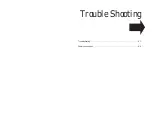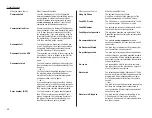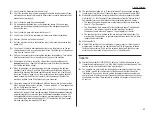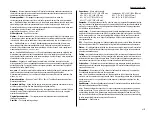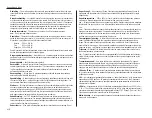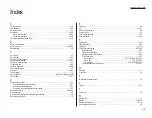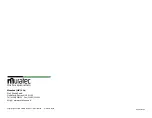
Redialling — The dialling again, either manually or automatically controlled, of the most
recently dialled fax or phone number. Automatic redialling follows an unsuccessful dialling
attempt.
Relay broadcasting — Lets some Muratec fax machines store a document in internal mem-
ory, transmits the document to the memory of a remote “hub” fax and then instruct that unit
to relay (re-transmit) the document to each fax in a call group in the “hub” unit. This feature
speeds extremely high-volume fax communication and allows a single command to initiate
document transmission to hundreds of preprogrammed fax locations. It also saves phone
charges for the originating machine. Your machine can initiate a relay broadcast.
Remote fax machine — The machine on the other “end” of a fax communication.
REN
— See Ringer equivalence number.
Resolution — The resolution of documents transmitted or copied by fax machines is mea-
sured by the number of horizontal (
H
) and vertical (
V
) lines per inch (lpi) the unit can print. A
Muratec unit may offer one or more of these resolution levels:
Normal
203
H
×
98
V
lpi
Fine
203
H
×
196
V
lpi
Superfine
203
H
×
392
V
lpi
Some Muratec units also offer grayscale transmission (see also Grayscale) for accurate repro-
duction of photographs and other shaded originals.
Ringer equivalence number — Also called
REN
. A number assigned to telecommunications
equipment used in the United States; designed to prevent overloading on a telephone circuit.
See also Load number.
Scanning width — See Effective scanning width.
SecureMail — Allows a Muratec fax user to send a document to or receive one into (usually
something confidential) an “electronic mail box.” The transmission is protected at the receiv-
ing Muratec fax by an access code; the receiving fax prints the document only when an
authorized user enters the code.
Secure polling — Polling in which preset passcodes are checked between two machines
before polling is allowed to take place.
Speed-dialling — Allows the fax user to store frequently used fax numbers for dialling with
the touch of three keys — an identifier key (either * or #) and then a three-digit code — for
each number. See also Autodialling and One-touch dialling.
Station
ID
— (Also called Location
ID
or Receiver
ID
.) An autodialer feature which lets the fax
user enter a descriptive name to correspond with the number in an autodialer entry. For
example, rather than entering only 1-972-555-3465, the user can enter that number and a
name, such as Dallas Branch Office. (Many Muratec models with this feature allow entry of
both upper-case and lower-case letters, for greater ease of reading.)
Subaddressing — An ITU-T standard allowing fax machines to specify special delivery
characteristics of a transmission. For example, subaddressing allows fax machines from dif-
ferent manufacturers to send and receive messages into confidential memory mailboxes, or to
retrieve specific files from polling memory.
Subscriber
ID
— A fax machine’s telephone number, as identified by a user setting. See
TTI
.
Super Group 3 — An extension of Group 3 fax technology standards, allowing the use of
high-speed v.34 bis modems for 33.6 Kbps transmission and high-speed protocols for rapid
handshaking.
Superfine resolution — 203
H
×
392
V
lpi. Your Muratec fax machine’s superfine transmis-
sion mode is Group-3-compatible, not the more limited proprietary version.
TAD
— Telephone answering device, or answering machine. Records incoming voice messages
for playback. You can connect a
TAD
to a Muratec fax machine and use the two on one phone
line.
TCR
— Transmit confirmation report; this provides proof that your Muratec fax did send the
document you set for transmission. Printed after transmission, the
TCR
also identifies the
telephone number to which the fax sent the document, plus the actual time of transmission
and how many pages the unit transmitted. See also
RCR
.
Thermal (paper) printing — A thermal head heats chemically treated, thermally sensitive
paper in patterns conforming to the image the machine has scanned, creating a printed
image. Thermal paper’s tendency to discolor and fade, in addition to its curliness and the
usual difficulty in writing on it, have made this method considerably less popular than plain-
paper fax printing — particularly as plain-paper fax machines have dropped sharply in price.
TriAccess — Muratec’s TriAccess allows a Muratec fax machine to perform three or more
tasks simultaneously without slowing.
TTI
— Transmit terminal identifier. A user-programmable line of information sent automati-
cally with every page a fax machine sends; it appears at the top of each page printed by the
receiving unit.
Transmission speed — How fast a fax machine is sending a fax document. This speed
depends upon the modem speed of each unit, the resolution setting, the content of the docu-
ment, the encoding technique and the condition of the phone line (clean, noisy, etc.) Any
change in any one of these five conditions will affect the speed, sometimes significantly.
V
.29 and v.27 ter — A standard set of communication procedures allowing fax machines to
talk to other units using those standards. Specifically, these standards cover fax transmission
at 9600 bps or slower.
V
.34 — An international standard for fax modems — and other modems — with transmission
speeds of up to 28.8 Kbps. The
V
.34 protocol is sometimes referred to as “
V
.Fast”, because it
represented a significant increase in possible transmission speed compared to the transmis-
sion protocol it replaced.
V
.34 bis — A faster version of the
V
.34 standard, and sometimes referred to as “
V
.34 Plus” or
“
V
.34 +”. The
V
.34 bis protocol allows transmission at up to 33.6 Kbps, and represents the cur-
rent maximum standard transmission speed possible under ITU-T Group 3. (The term “bis” is
French, and designates the “second” version of the protocol.)
White-line skip — A technique used to speed up fax transmission by bypassing redundant
areas, such as white space.
Appendix and index
AI
.4
Summary of Contents for MFX-2500
Page 1: ...Muratec MFX 2500 Operating Instructions Fax Reference...
Page 7: ...v This page intentionally blank...
Page 73: ...Beyond the Basics This page intentionally blank 2 51...
Page 84: ...Trouble Shooting Troubleshooting 4 1 Common questions 4 6...
Page 93: ...Trouble Shooting This page intentionally blank 4 9...
Page 94: ...Appendix and index Glossary AI 1 Index AI 5...
Page 101: ...This page intentionally blank Appendix and index AI 7...
Page 102: ...This page intentionally blank Appendix and index AI 8...

